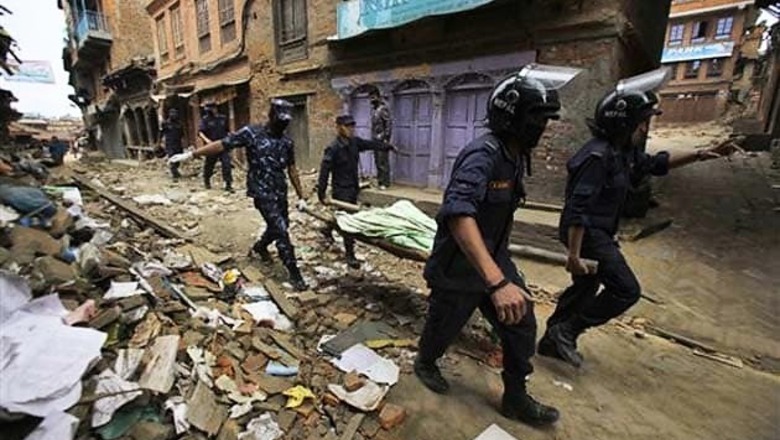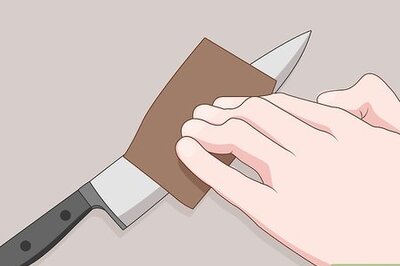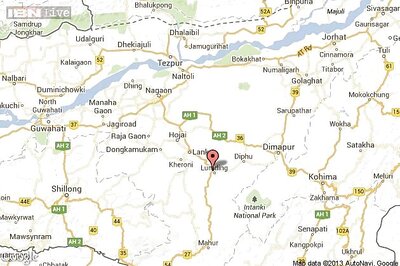
views
Kathmandu: Racing against time, rescuers on Sunday waded through tonnes of rubble of flattened homes and buildings in Nepal to look for survivors of the earthquake that has killed over 2,350 people, including five Indians, and left more than 6,000 others injured.
Fresh powerful aftershocks on Sunday triggered panic among the stricken people and caused avalanches on Mt Everest which had on Saturday taken a toll of 22 lives.
A strong 6.7-magnitude aftershock followed by another measuring 6.5 on the Richter Scale, sent people scrambling for open spaces.
The 7.9-magnitude temblor on Saturday left a trail of devastation and suffering, with people spending the cold night in the open because of fears of fresh quake.
According to the latest figures available with the Kathmandu-based National Emergency Operation Centre, the death toll in Nepal stood at 2,352 and 6,239 had been injured.
1,053 people are reported killed in the Kathmandu Valley alone. Officials fear the death toll could rise as desperate search for survivors continued.
International rescue teams, including from India, have touched down in Kathmandu as Nepal declared a state of emergency in the wake of the disaster, the worst in over 80 years of the country's recorded history.
India has mounted a major rescue and rehabilitation effort, deploying 13 military aircraft which carried medicines, field hospitals, blankets, 50 tonnes of water and other materials.
More than 700 disaster relief experts drawn from the National Disaster Relief Force have been deployed by India. A senior-level inter-ministerial team will visit Nepal to assess how India can better assist in the relief operations.
Rescuers have been hunting for survivors under heaps of debris with bare hands as well as heavy equipment though the efforts have been hampered due to fresh tremors, thunderstorms and snowfall in the mountain ranges.
Locals and tourists sifted through mounds of debris for survivors. Cheers rose when people were found alive, though mostly bodies were pulled out.
MI-17 helicopters of the Indian Air Force (IAF) have carried out five casualty evacuation sorties and the injured have been moved to military hospitals.
An Indian attempting to climb all the highest peaks in the seven continents, 54-year-old Ankur Bahl is also stuck at Camp II on Mount Everest along with 11 other fellow climbers.
Bahl had moved to Camp II from Camp I on Saturday but is now stranded due to the earthquake.
The earthquake and the aftershocks left behind a trail of death and destruction, flattening houses and buildings, including the iconic Dharhara tower and the landmark Darbar Square in the heart of the capital, trapping scores of people.
According to initial reports related to Sunday's aftershock, a tunnel caved in at the Trishuli Hydel Project and around 60 labourers are feared trapped.
Hospitals in Nepal are struggling to accommodate the number of injured that is running into thousands. People have been lying scattered on the floor and even on the ground outside and receiving treatment.
The Nepalese government has established a fund of Rs 500 million for the reconstruction of the damaged infrastructure.
With electric poles and lines uprooted, most parts of the country have no electricity since Saturday afternoon and authorities say the situation is likely to continue for the next few days.
26 districts are the most affected in Nepal though the far western part of the country has been declared safe.
Offers of help poured in from around the world following the Nepalese government's appeal for assistance, with the US, the European Union as well the United States saying they were sending in disaster response teams.
Nepal has requested international assistance in the response to the disaster, with particular importance placed on the search and rescue capacity, medical teams, supplies and tenting for hospitals, heavy equipment for rubble removal and helicopters for transport and access to blocked areas.
A large number of Indians, including many workers who visit the neighbouring country, said they were faced with basic problems like food and sanitation.



















Comments
0 comment